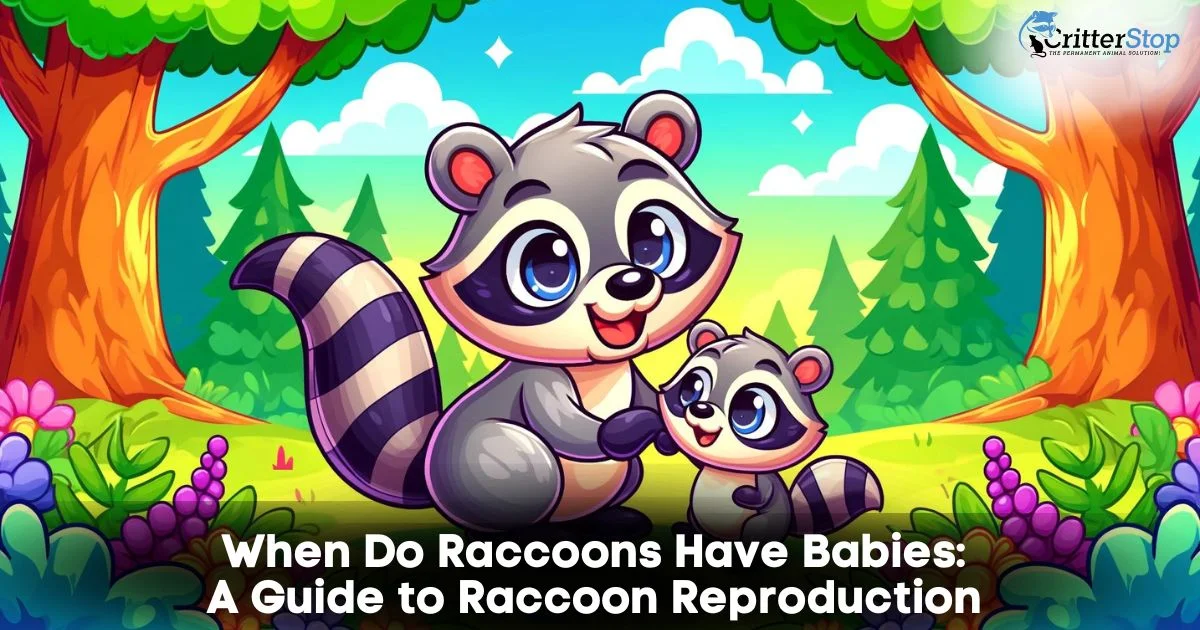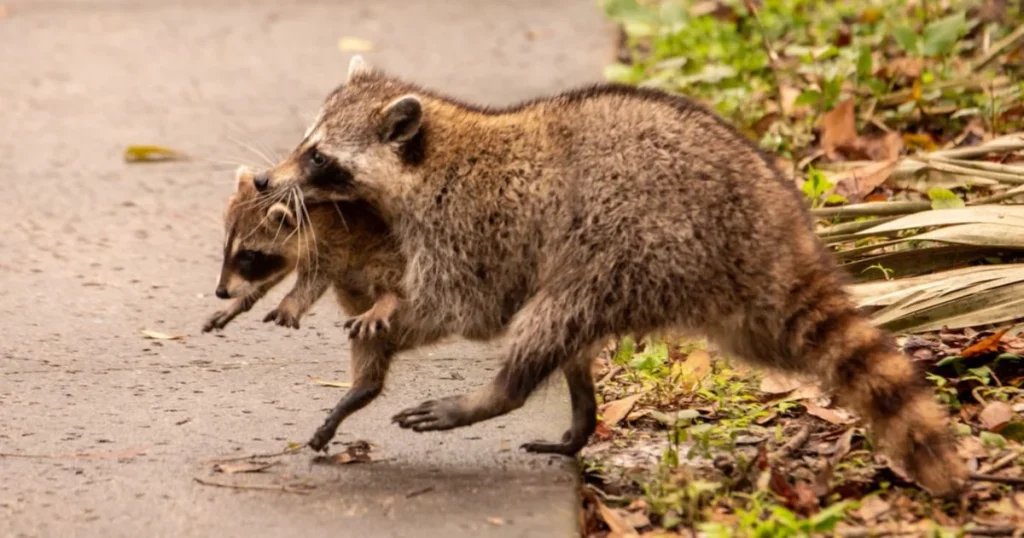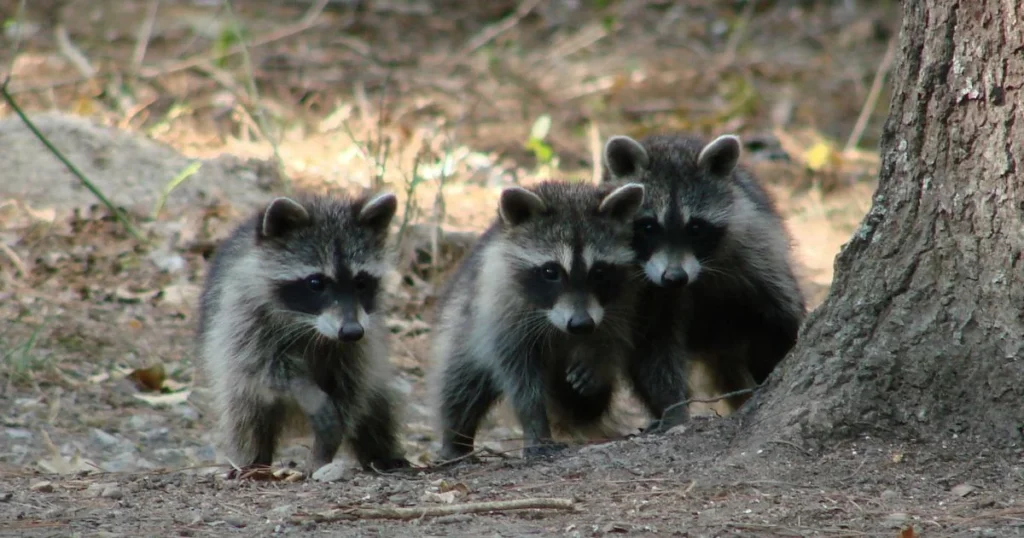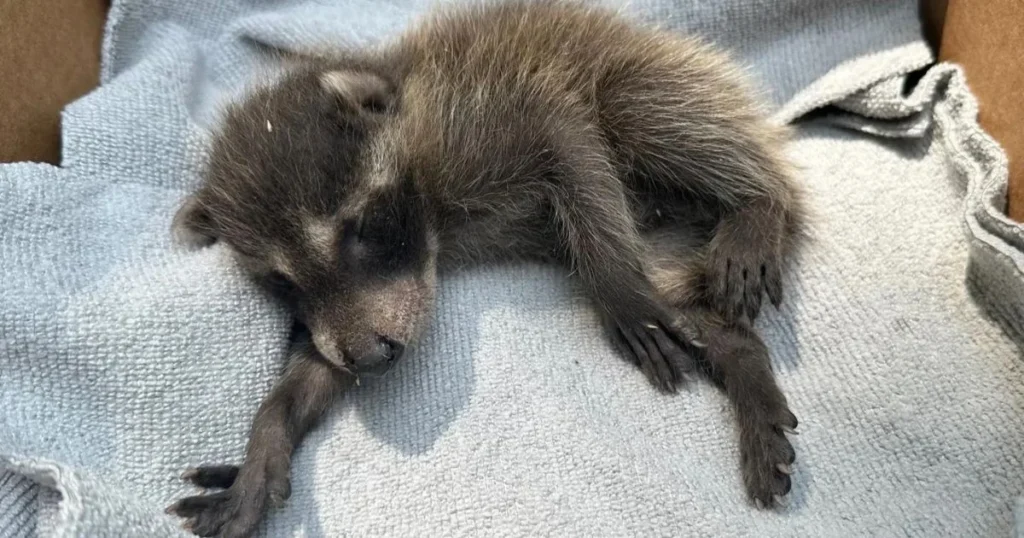
Raccoons are fascinating creatures that are often found in urban and suburban areas. They are known for their mischievous behavior, unique markings, and their tendency to rummage through garbage cans. One fascinating facet about raccoons is their reproductive cycle. If you're wondering when do raccoons have babies, you've come to the right place.
Raccoons usually breed during late winter or early spring, with the babies being born in the spring or early summer. The precise timing may vary depending on the specific location and climate, but generally. Female raccoons usually have litters of 3-5 babies, also called kits, though larger litters are also quite common.
It's important to note that raccoons are notorious for making their homes in attics, crawl spaces, and other areas of human dwellings. If you think raccoons may be residing in your house, it's crucial to address the situation promptly. These animals can not only inflict damage on your property, but they also represent a health hazard to you and your family.
Raccoons are known for their distinctive black mask and ringed tail. However, they are also known for their breeding patterns. In this section, we will discuss the breeding habits of raccoons, including their mating season and gestation period.
Raccoons are polygamous animals, meaning that they mate with multiple partners during the breeding season. The mating season for raccoons usually commences in late winter or early spring, typically between February or early March. During this time, male raccoons will actively search for female raccoon to mate and see how many babies they can have together.
After mating, the female raccoon will carry the offspring for a gestation period of approximately 63 days. The gestation period may vary slightly depending on the individual, but it typically lasts between 60 and 73 days. Female raccoons can give birth to litters of up to seven offspring, although the average litter size is around three to five.
It is important to note that female raccoons are solitary animals when it comes to raising their young. Following birth, the female raccoon will nurture the offspring on her own, without any assistance from the male raccoon. The young raccoons will remain with their mother until they are around nine to ten months old, at which point they will become independent and leave to establish their own territories.
In conclusion, raccoons have a specific breeding season and gestation period, which allows them to produce offspring for the continuation of their species. Understanding the breeding patterns of raccoons can assist us in gaining a deeper understanding of these captivating creatures and their significance within the ecosystem.
Raccoons are known for their distinctive black mask and ringed tail, but they are also known for their unique birthing and nesting habits. In this section, we will explore the birthing and nesting habits of raccoons.
Female Raccoons typically give birth in the spring, with most births occurring in April and May. The gestation period for raccoons lasts approximately 60 days, and litters usually consist of 2-5 raccoon kits. However, in some cases, litters can be as large as 8 kits.
Female Raccoons are solitary animals, and females will typically seek out secluded areas to give birth. They may choose to give birth in tree cavities, hollow logs, or even in attics or crawl spaces of your house. Female raccoons are protective of their offspring and will vigorously defend them if they perceive any threat.
Raccoons are adaptable animals and will make their nests in a variety of locations. In urban areas, raccoons may choose to make their nests in attics, chimneys, or other areas of homes. In rural areas, they may choose to nest in hollow trees, logs, or even in abandoned buildings.
Raccoons are opportunistic creatures and will exploit any available resources to build their nests. They may use leaves, grass, and other materials to construct their nests. Female raccoons will typically move their young to a new nest every few weeks to protect them from predators. Is rare seeing the male raccoon taking care of young raccoons.
In conclusion, raccoons have unique birthing and nesting habits that enable them to adapt to various environments. Understanding these habits can help us coexist with these animals and appreciate their role in our ecosystem.

Raccoons are known for their distinctive black mask and ringed tail. Baby raccoons, also called kits, are typically born with their eyes and ears closed and a very fine coat of fur. They rely entirely on the female raccoon for survival and nurturing.
As the baby raccoons grow, their fur becomes thicker and more visible. They start to develop their characteristic black mask and ringed tail around 2-3 months of age. Their eyes and ears open around 3-4 weeks old, revealing bright blue eyes and small, rounded ears. Baby raccoons are typically born with grayish-brown fur, but as they grow, their fur color can vary from reddish-brown to black.

Baby raccoons grow quickly, and their milestones are important indicators of their development. At 2-3 weeks, they start to crawl and explore their surroundings. By 6-8 weeks, they can climb trees and begin to eat solid food, this is one of the most common behavioral signs of they leaving the young stage to become adults. Adult raccoons typically reach their full adult size around 1 year old.
Baby raccoons usually leave the nest around 8-12 weeks old, however, they may remain with their mother for about a year. Throughout this period, they acquire crucial survival skills such as hunting and foraging. It is not uncommon to see baby raccoons out during daylight hours, especially if their mother is nearby. However, it is important to remember that raccoons are nocturnal animals and should not be approached or disturbed.
Overall, baby raccoons are fascinating creatures that go through many changes as they grow and develop. By understanding their physical appearance, growth milestones, and leaving the nest, we can appreciate these animals and their place in the natural world.

When it comes to caring for orphaned raccoons, there are a few things to keep in mind. It's important to note that raccoons are wild animals and should not be kept as pets. However, if you come across an orphaned raccoon, there are measures you can take to help guarantee its survival.
When it comes to feeding orphaned raccoons, it's crucial to offer them a diet that resembles what they would consume in their natural habitat. This means feeding them a combination of fruits, vegetables, and protein sources such as eggs or chicken. It's crucial to steer clear of providing them with processed foods or anything containing excessive sugar.
Alongside offering a balanced diet, it's also vital to ensure the raccoon is adequately hydrated. This can be achieved by providing a shallow dish of water or by using a syringe to administer water directly.
When caring for orphaned raccoons, it's important to provide them with a safe and secure habitat. This can be done by creating a nesting box or enclosure that is large enough to allow the raccoon to move around freely.
It's also important to ensure that the habitat is free from any potential hazards such as sharp objects or toxic chemicals. Additionally, it's important to provide the raccoon with plenty of enrichment activities such as toys or climbing structures to help keep them mentally stimulated.
Overall, caring for orphaned raccoons can be a challenging task, but with the right knowledge and resources, it's possible to help ensure their survival. By providing a balanced diet, a safe and secure habitat, and plenty of enrichment activities, you can help give these animals the best chance at a healthy and happy life.
Before considering adopting or purchasing a baby raccoon, it is important to understand the wildlife regulations in your area. In the United States, raccoons are classified as a "nuisance animal" and are governed by state and local laws. These regulations differ from state to state, so it's essential to research the laws specific to your area.
In most instances, it's against the law to keep a wild raccoon as a pet. This is because raccoons are considered a wild animal and can carry diseases that can be transmitted to humans. In addition, raccoons are known to be destructive and can cause damage to property.
If you are interested in adopting a baby raccoon, it is important to find a licensed wildlife rehabilitator in your area. These individuals are trained to care for injured or orphaned wildlife and can help ensure that the raccoon receives proper care and is released back into the wild once it can survive independently.
It is important to note that buying or selling baby raccoons is illegal in many states. In addition, purchasing a baby raccoon from an unlicensed seller can put you at risk of buying a sick or injured animal.
If you are interested in adopting a baby raccoon, it is important to do your research and find a reputable breeder or wildlife rehabilitator in your area. These individuals can provide you with information on the proper care and feeding of baby raccoons, as well as any legal requirements for owning a raccoon as a pet.
It is also important to consider the long-term commitment involved in owning a raccoon. Raccoons can live up to 20 years in captivity and demand a substantial investment of time and attention to uphold their health and welfare.
In conclusion, before considering adopting or purchasing a baby raccoon, it is important to understand the legal and ethical considerations involved. Research the wildlife regulations in your area and only work with licensed breeders or wildlife rehabilitators to ensure the human removal of the raccoon and that the animal is properly cared for and released back into the wild when appropriate.
Raccoons, a common sight in North Texas, usually give birth during the late spring and early summer months. This period is crucial as it coincides with an abundance of food that helps the mother raccoon nourish her young raccoons. Newborn raccoons spend the first few weeks of their lives hidden away in nests, which can often be found in secluded areas such as tree hollows or even in the attics of unsuspecting homeowners. The presence of these animals can become particularly noticeable as they forage more aggressively around human habitats to support their growing young.
As raccoons search for safe and warm environments to raise their offspring, attics often become prime targets, posing a risk to homeowners. During late summer, juvenile raccoons start to venture out with their mothers to look after food and learn the ropes of foraging and survival, which can lead to more frequent sightings and interactions.
Homeowners should be aware of the high-risk period when raccoons are most active, especially near human dwellings, as these raccoon families are known to cause significant damage in their quest for shelter and food. Managing and mitigating this risk requires timely intervention and professional assistance from pest control experts like Critter Stop. We always recommend calling experts when you are suspected of having this animal inside your attic or walls because, in just a few weeks, they can produce a lot of damage to your property and their presence represents a health problems for you and your family.
We have discovered When Do Raccoons Have Babies, how many raccoon kits you will find, and much more. We also have found that besides they are lovely creatures, can put at risk your house and family. If you believe there are baby raccoons on your property, it is crucial to act swiftly to ensure their safety. The first step to prevent raccoons inside your house is to identify the potential entry point that they could be used to get inside. After we took care of that entry point, we needed to set some traps to catch the animal.
One option is to contact a professional wildlife removal service, such as Critter Stop, to safely take care of the baby raccoons from your property. Our humane removal services take care not only of the baby raccoons but the entire family. Yes, we don't want to split the mother raccoon from their baby, and, if we find the male raccoon there, we will safely remove all the raccoons from that space. This, will not only ensure the safety of the raccoons, but it will also prevent any potential damage to your house.
If you do choose to remove the baby raccoons yourself, it is important to do so safely and responsibly. Critter Stop offers resources and guidance on how to safely remove and relocate baby raccoons, as well as information on how to prevent future raccoons infestations. Before removing, we always recommend prevention. Be aware of noise in your attic, walls, or ceiling. Droppings are also a good sign of the raccoon's presence, if you find one of these hints, try to put some cayenne pepper around your house, sometimes helps to keep female raccoons away.
Remember, it is never a good idea to purchase baby raccoons as pets. Not only is it illegal in many areas, but it can also be dangerous for both the raccoon and the owner. It is always best to leave wildlife in their natural habitat and seek professional help if necessary.
In conclusion, if you suspect that there are baby raccoons on your property, contact a professional wildlife removal service such as Critter Stop for safe and humane removal. Do not attempt to remove or purchase baby raccoons yourself, as it can be dangerous and illegal. If you need more guidance, contact us at (214) 234-2616. and our expert will be glad to help you!
Raccoons typically birth their babies, also called kits, in the early springtime, usually between February and March. Anyway, the exact moment can vary depending on the location and climate. Female raccoons tend to give birth in dens or other secluded areas, such as hollow trees or burrows.
Raccoons can have anywhere from one to eight offspring in one litter, but the average litter size is usually around three to four kits. The number of kits in a litter can also vary based on factors like the mother's age, health, and access to solid food.
Baby raccoons usually stay with their mother for around nine to ten months before leaving the nest. raccoons begin more independent as they grow and gradually start to explore their surroundings. By the time they are around four months old, they can climb trees and forage to find food on their own.
Signs of a nearby young raccoon may include chirping or chattering sounds coming from a den or other secluded area, as well as tracks or droppings near the den entrance. It's important to remember that raccoons can be protective of their young, so it's best to keep a safe distance and avoid approaching the den.
Raccoons typically have their babies in dens or other secluded areas, such as hollow trees, burrows, or attics. Female raccoons will often create a nest out of leaves and other materials to provide a warm and safe environment for their offspring.
No, raccoon litters are not common during the winter months. Female raccoons usually mate in the late winter or early spring, and give birth in the early springtime. Mother Raccoon is also known to go into a state of torpor during the winter months, where their metabolism slows down and they become less active.
Raccoons face a range of potential predators in the wild, including large birds of prey like eagles and owls, coyotes, bobcats, mountain lions, and occasionally large constrictor snakes. In urban areas, domestic dogs can also pose a threat. Additionally, humans, through hunting, trapping, or habitat destruction, can impact raccoon populations. In regions where alligators or crocodiles are present, they may also prey on raccoons, particularly near water sources. These predators play a role in regulating raccoon populations and influencing their behavior and habitat use. These predators normally target young raccoons but also can look for adult raccoon if the situation is good for them.
Raccoon roundworm, known scientifically as Baylisascaris procyonis, is a type of parasitic worm that commonly infects raccoons. The eggs of this parasite are shed in the feces of infected raccoons and can contaminate the soil, water, or other surfaces where raccoons are present.
Once laid, raccoon roundworm eggs can become infectious within a few weeks and are extremely resistant to environmental conditions, surviving for years in the environment. If accidentally ingested by humans, these eggs can hatch into larvae and cause a serious infection known as baylisascariasis. This condition can lead to severe neurological damage and other systemic issues, as the larvae migrate through various organs, including the brain and eyes.
Raccoon baby season, often referred to as the birthing period for raccoons, typically occurs in the spring. Most raccoon litters are born between February and June, with the peak of births usually happening in April and May. During this time, mother raccoon seek out safe and secluded areas to give birth and raise their young, such as hollow trees, abandoned burrows, or even urban spaces like attics and garages.
This period is critical as the mother raccoon needs to find ample food and a safe shelter to nurse and protect her kits until they are old enough to accompany her in foraging activities. The kits are usually weaned by about 12 weeks of age and will start learning essential survival skills from their mother shortly thereafter.
Raccoons are opportunistic when it comes to finding nesting sites, and in residential areas, the most common places for a raccoon to nest inside a house is the attic and the walls. Attics provide a quiet, secluded, and often undisturbed environment that is ideal for mother raccoons to give birth and raise their young. The insulation commonly found in attics also makes these spaces particularly appealing to raccoons as it provides comfortable bedding material and helps regulate temperature.
Aside from attics, as we said before, other of the most common places within a home can include crawl spaces, chimneys, and underneath decks or porches. Raccoons may also take advantage of open garages, sheds, and even the spaces between walls if entry points are accessible. To prevent raccoons from nesting in these areas, especially in walls and attic, it's important to ensure that any potential entry points are securely sealed and to regularly inspect your home for signs of wildlife activity.
As raccoons reach breeding age, typically around their first year, there is a noticeable rise in their activity, particularly in urban and suburban areas. This rise in activity coincides with the raccoon mating season, leading to an increase in the number of young raccoons that can be found exploring new territories. These young raccoons, learning to fend for themselves, often venture into chimneys and other accessible structures in search of safe nesting sites. Homeowners should be particularly vigilant during this time as the presence of raccoons can lead to damage and potential health risks.
The age at which raccoons begin to reproduce contributes to the rise in population numbers each spring. During this peak period, it's not uncommon to find young raccoons nestled away in chimneys, where they are born and spend the first few months of their lives. The use of chimneys as nesting sites poses significant challenges for homeowners, who may hear the distinct sounds of young raccoons calling to their mother. To manage this rise in raccoon activity effectively, professional pest control services such as those provided by Critter Stop are essential in safely relocating these animals and securing homes from future invasions.
Visit our Critter Library and learn more about our furry friends